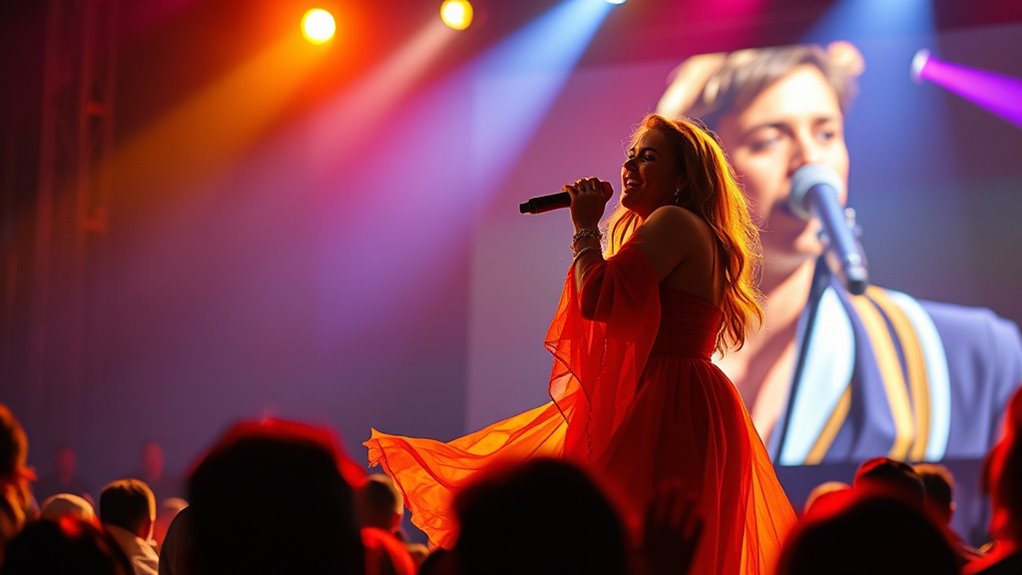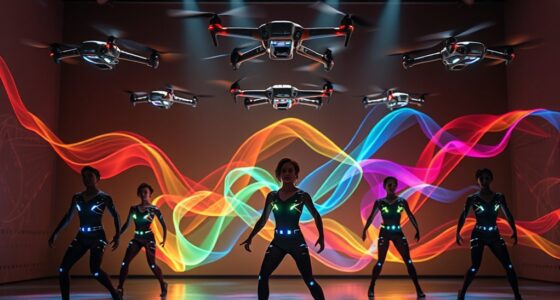Playback singing involves recording vocals in a studio for a polished, edited track, while live singing is performed in real-time before an audience without edits. In playback, you focus on perfecting your voice beforehand, and technicians handle the technical polish. Live singing requires quick thinking, stamina, and emotional authenticity. Both need solid training, but they serve different industry roles. If you want to understand these differences more deeply, keep exploring each aspect further.
Key Takeaways
- Playback singing involves studio-recorded vocals played during filming or performance, while live singing is performed in real-time in front of an audience.
- Studio singing allows multiple takes and editing, whereas live singing demands immediate, unedited vocal delivery.
- Playback singers focus on perfecting tone and pitch beforehand, while live singers develop endurance and emotional expressiveness.
- Studio recordings produce polished tracks for media, while live singing creates a direct, authentic connection with the audience.
- Both require solid vocal training, but each emphasizes different skills: technical precision for studio work, emotional authenticity for live shows.

When it comes to vocal performances in the entertainment industry, playback singing and live singing are two distinct approaches that often spark debate. Playback singing involves recording vocals in a studio, where artists focus on delivering their best takes without the pressure of a live audience. These studio recordings become the polished versions that audiences hear in movies, TV shows, or music videos. As a singer, you invest significant time in vocal training to perfect your tone, pitch, and expression before stepping into the studio. Vocal training helps you develop the control and consistency needed to produce high-quality recordings, ensuring each note sounds flawless. When working on studio recordings, you often have the luxury of multiple takes and editing, allowing you to fine-tune your performance until it meets professional standards. This process emphasizes precision, technical skill, and the ability to adapt your voice to different styles or moods. Additionally, the use of studio technology enhances the final sound, making the recordings sound even more polished.
In contrast, live singing demands a different set of skills. Performing in front of an audience means you have to deliver your vocals in real-time, often without the safety net of editing or retakes. The energy of the crowd, the acoustics of the venue, and your physical condition all influence your performance. Live singing requires you to be well-prepared through rigorous vocal training, as it challenges your endurance, pitch accuracy, and emotional expression on the spot. Unlike studio recordings, where mistakes can be corrected behind the scenes, a live performance leaves little room for error. You need to stay focused, maintain vocal health, and adapt instantly to unexpected circumstances, like sound system issues or environmental noise. This spontaneity can be exhilarating but also nerve-wracking, especially if you’re not confident in your vocal stamina or technique.
Both approaches serve different purposes in the entertainment industry. Studio recordings are ideal for creating polished, consistent tracks that can be distributed widely, while live singing connects you directly with your audience, showcasing your raw talent and emotional authenticity. Whether you’re recording in a studio or performing on stage, solid vocal training forms the foundation of both methods. It enhances your control, helps prevent strain, and allows you to adapt your voice for various contexts. Ultimately, understanding the difference between playback singing and live singing equips you to choose the right approach for each opportunity, ensuring your performances are both impactful and technically sound.
Frequently Asked Questions
Can Singers Perform Both Playback and Live Singing Professionally?
Yes, you can perform both playback and live singing professionally. Many singers develop their vocal versatility to excel in studio recordings and live performances. Playing both roles requires adapting your voice to different settings, whether syncing with visuals in a studio or engaging an audience on stage. With proper training and experience, you can master the skills needed for both, making you a well-rounded artist capable of thriving in various professional singing environments.
How Do Singers Prepare Differently for Playback Versus Live Performances?
Did you know singers spend up to 30 minutes on vocal warm-up routines daily? When preparing for playback, you focus on perfecting your tone and consistency, so you might do less on stage presence techniques. For live performances, you emphasize stage presence techniques, physical warm-ups, and energy-building exercises. Your goal is to deliver a dynamic show, so you adapt your vocal warm-up routines and stage presence strategies accordingly.
What Equipment Is Essential for Live Singing Compared to Playback?
For live singing, you need vital equipment like reliable microphone types, such as dynamic or condenser mics, suited for stage use. Sound mixing equipment is essential to balance your voice with the venue’s acoustics. Unlike playback setups, you’ll rely on these tools to project your voice clearly and adapt to the environment. Make sure your microphone is comfortable and your sound system is properly configured to deliver an ideal performance.
Are There Specific Training Techniques Unique to Playback Singing?
Imagine opening a secret to perfect performance. For playback singing, you focus on unique training techniques like tailored vocal warm-ups to guarantee your voice remains smooth and flexible without live pressure. You also hone emotional expression, mastering subtle nuances that connect with the recording. These specialized practices help you maintain consistency and emotional depth, making your playback performances engaging and seamless, distinct from the live singing skills you develop for stage presence.
How Does Audience Interaction Vary Between Live and Playback Performances?
You notice that in live performances, your audience engagement is immediate, and your stage presence plays a big role in connecting with them. You thrive on their reactions, making eye contact and responding to their energy. In playback singing, your focus shifts to perfecting the performance without direct audience interaction, so stage presence becomes more about delivering emotion through your voice. The dynamic of engagement differs markedly between the two.
Conclusion
Ultimately, whether you prefer playback or live singing, remember that both have their magic—like a Shakespearean sonnet or a jazz improvisation. Playback offers a polished, flawless performance, but live singing captures raw emotion and spontaneity. Each has its place, just as night and day do. Embrace the beauty in both, for in their harmony, you find the true essence of musical artistry—proof that, like music itself, life thrives in balance.









